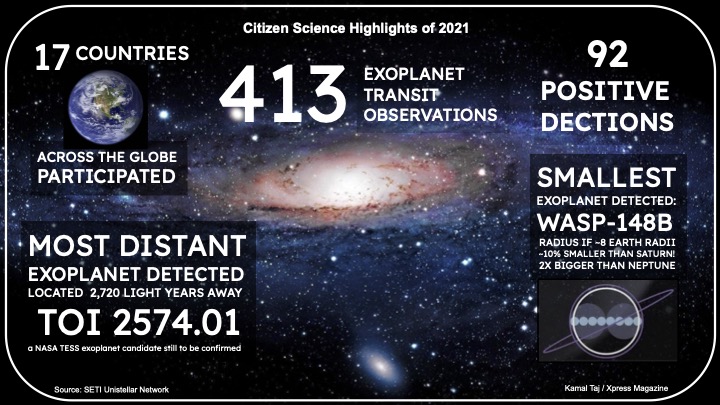S.E.T.I. Phone Home
S.E.T.I., an institute that specializes in society’s curiosity of the cosmos, attempts to expand its knowledge of the universe — moreso, whether we’re alone in it or not.
The top of the Cesar Chavez Student Center on campus under the light of the full moon in San Francisco, Calif., on Dec. 7, 2022. (Tatyana Ekmekjian / Xpress Magazine)
Looking up at the night sky, it’s easy to get lost in the vastness of space — a nebulous murk speckled with points of brilliance. Mysterious planets orbit massive burning fusion reactions, smoldering light years away from earth. These planets, invisible to the naked eye, may hold the answer to one of our biggest questions of the cosmos: are we alone?
Nestled in the foothills of Berkeley, one research center focuses on answering that. The Search for Extraterrestrial Intelligence (SETI) is an ongoing project conducted by researchers all over, including the Bay Area and UC Berkeley. The Berkeley SETI Center has situated itself at the forefront of the research of optical and electromagnetic transmissions that originate beyond Earth. However, the search for life in the universe is much more than pointing a telescope at something weird and declaring it to be aliens.
The objects in our night sky vary drastically. From quasars to pulsars and neutron stars to planetary nebulas, the observable universe is filled with celestial objects that leave researchers with more questions than answers. For some, an endless void filled with potentially unanswerable questions could leave them feeling hopeless, but for SETI researchers, this is their specialty – quantifying the seemingly unquantifiable.
The SETI Institute began in 1984 in Mountain View, California, and came about as a result of members of a smaller NASA-funded project coming together to maximize the efficiency of their research. NASA, prior to the institute’s inception, was already conducting research on extraterrestrial techno-signatures, and their possible origins. Discussions between project members eventually led to an idea of a non-profit research organization focusing on the science brought about by the Drake Equation.

The Drake Equation, (N=R* × fp × ne × f1 × fi × fc × L) founded by Frank Drake — one of SETI’s first trustees — estimates the potential number of active, communicative extraterrestrial civilizations in the Milky Way galaxy. The equation was formulated in 1961, and essentially breaks down the probability of ‘intelligent life’ in our galaxy. (R*) equals the average rate of star formation in our galaxy and (fp) equals the fraction of those stars that have planets. (ne) equals the average number of planets that can support life per star with planets and (f1) equals the fraction of those planets that could support life. (fi) equals the fraction of those planets with life that could develop ‘intelligent life’ and (fc) equals the fraction of civilizations that develop technology that could release detectable signs of their existence. Lastly, (L) equals the length of time for which such civilizations release detectable signals into space.
“The search for extraterrestrial intelligence is central to our understanding of the universe and our view of ourselves,” Carl Sagan, once a member of the SETI Institute’s board of trustees said.
On a calm Tuesday afternoon in November, amber leaves rustle in the autumn breeze. The Campanile towers over Campbell Hall and casts a long shadow across Memorial Glade
The heavy, wooden framed glass doors of Campbell Hall swing open, leaving behind the brightly colored chalk graffiti on its exterior. The warm, quiet lobby welcomes one to Berkeley’s Astronomy Department. Up on the third floor, the modest, office-like interior might have one fooled into thinking they’re in the wrong place. Maybe unassuming is what they’re going for? No one wears lab coats, no one runs around with clipboards, and there aren’t multiple monitors or flashing lights. It’s just a man in an office behind a desk — David DeBoer.
DeBoer, Research Astronomer at UC Berkeley and the SETI Research Center, has been with the organization since the ‘90s.
“I haven’t done SETI my whole career, although I’ve been tangentially involved with it…in some ways it’s a little random,” said DeBoer with a laugh.
When working on his Ph.D in planetary astronomy, DeBoer met a colleague working for the SETI program. He got involved early on, writing software to help predict potential problems with satellites, like when one satellite would have conflicting trajectories with another.
DeBoer later started working directly with Project Phoenix, the most sensitive and comprehensive search for extraterrestrial intelligence that had been conducted up until 2015. His software was used by them, and he became a faculty member at the Parkes Observatory in Australia where Project Phoenix was being conducted at the time.
DeBoer also helped create a backup observatory site at Georgia Tech, where he was once a professor, and found his way to the Bay Area when development of the Allen Telescope Array began. The ATA is the first radio telescope designed to be specifically used for SETI searches located in Northern California.
The facility at Berkeley focuses primarily on radio frequency searches conducted onsite that use radio telescopes, rather than data from observatories or optical telescopes. However, they do process some data from these different types of facilities, crunching the numbers for places like the Automated Planet Finder at Lick Observatory in Mount Hamilton, California, and the Large Synoptic Survey Telescope in Chile.
Radio frequencies or techno-signatures of interest are essentially signals detected and ruled out as being caused by natural, “known” physics. SETI focuses on these particular signatures that lie outside the realm of average physical signals.
“Sometimes it gets challenging…pulsars were an interesting challenge, but compared against that diagram of reasonable naturally occurring signals, they still lie within the boundary,” said DeBoer.
Pulsars are rapidly-rotating neutron stars that regularly emit pulses of radiation.. These celestial objects essentially act like spinning lighthouses, emitting massive amounts of magnetic fields from their poles every millisecond to second — which, in turn, shoot beams of radio waves into space. These objects often lead researchers to think they’ve found something extraterrestrial, only to discover it’s explainable by natural physics.
“If we look out and see a signal that isn’t (something created by nature), then we think that some intelligent technological species has produced it,” said DeBoer.
Ideally, researchers would love to be able to search vast portions of space for signatures — but that’s very computationally intensive. Recently, the Hubble Telescope took a long-exposure photograph of what initially looked like a relatively empty portion of the night sky. The image that came back revealed not only stars, but entire galaxies hiding in plain sight — in total, nearly 3000 celestial objects otherwise unknown to astronomers.

The Berkeley SETI Research Center works on multiple larger programs researching extraterrestrial signals. One of them is Breakthrough Listen, a 2015 initiative that contributed $100 million in funding toward a 10-year plan to find signs of intelligent life in the cosmos. It was funded primarily by Yuri Milner, a Soviet-born Israeli venture capitalist and billionaire who also dabbles in physics.
Recently, the Breakthrough Listen Candidate 1 (BLC1) radio signal piqued SETI’s interest. The radio signature was observed during April and May 2019 by the Parkes Observatory in New South Wales, Australia. Scientists initially thought it might be coming from Proxima Centauri — one of the closest star systems to our own solar system.
The features of the signal aroused interest. The signature was a few Hz wide — a narrowband signal, usually indicative of a technological source, not a typical astrophysical one. The signal also appeared to be absent in off-source observations, which is expected for a signal coming from a single point in the sky. It not only persisted for a few hours, but also drifted at a rate that appeared nearly linear, shifting slightly over time — behavior that would be expected for a transmitter in a rotational or orbital environment. Was it aliens?
Unfortunately — or fortunately, depending on one’s opinions of extraterrestrial creatures — the source of the signal was later deemed to be simple radio frequency interference originating from Earth. But, these signatures ultimately help researchers to better tell the difference between interesting or interference.
If we haven’t found signs of intelligent life yet, why should we continue? Why keep searching? If it hasn’t happened yet, will it ever?
For DeBoer, SETI’s work is about more than being the first to find aliens.
“Part of the Breakthrough Listen mission is provide the world’s greatest archive of data that people can use,” said DeBoer.
Dr. John Brewer is a professor at SF State specializing in exoplanetary science, the study of planets beyond our solar system. He finds the field of astronomy new and exciting.
“What really caught my eye was research into exoplanets…back in 2010, there was a few hundred that had been discovered, now there’s a border of 5,000 discovered,” said Brewer.
Brewer, who actually studied photography in his undergrad, is not involved in SETI’s research. But he feels that looking for exoplanets is key to figuring out if we’re alone in the universe.
“There’s a lot of pieces to figuring out whether or not there could be anybody out there,” said Brewer, “I think it’s a question that we’ve asked for thousands of years, before we even knew what a telescope was.”
Humanity has wondered if we were the only things in existence for almost our entire history and some might say that religion attempts to put those thoughts to rest by saying that we are.
“Knowing how we got here in the first place requires knowing about more than just us,” said Brewer.
The field of astronomy is constantly changing. Brewer mentioned how something like astronomers’ grasp of how planets are formed has changed over time, along with other ideas that have been almost entirely refuted. If things we thought we knew have been disproved, what will change in another few years?
Alan Chew, a 4th-year grad student at SF State, has been working with Dr. Brewer on exoplanetary research. He’s also been involved in the UC Berkeley SETI online project that allows volunteers to monitor signals.
“They’ve got all this massive data from radio telescopes from around the world and (you can) go through all of that, looking for a signal that might be interpreted as a signal from an extraterrestrial source,” said Chew.
In the SETI@Home project, anyone could process data which the SETI Research Center uploaded. It launched in 1999 and continued until 2020.
Chew, an older alumni from UCB is actually retired from nearly 40 years of K-12 private education. However, after retiring he decided, “You know what, the astronomy that I learned when I was an undergrad is all obsolete now…and I decided to go back and I entered the masters program at SF State.”
Chew would watch the data on his PC and see all of the random radio signals that would come through and try to look for something irregular that would indicate something other than just noise. Looking back he remembers going on a field trip as a kid to the Chabot Space and Science Center in the Oakland Hills and credits the center for his interest.
“Ever since then I’ve been excited about astronomy and tried to do public outreach type stuff to get other people excited too.” said Chew.
Dr. Brewer’s work with the 100 Earths Project caught Chew’s eye. Its goal was to try and find an Earth 2.0., another planet capable of sustaining life. These projects tie back into our understanding of ourselves and our place in the cosmos.
“I am a person of faith, but I believe there is value in understanding the universe to its fullest extent, and finding an answer to questions that society has yet to answer,” said Chew.



